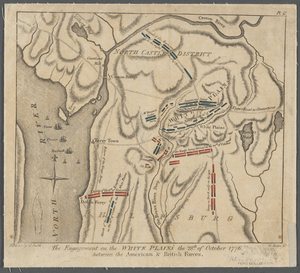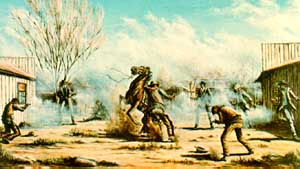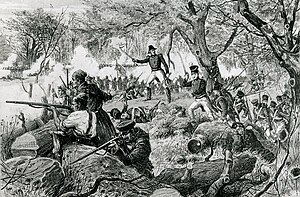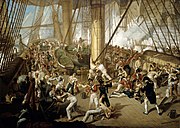October 23, 1942, The Battle of El Alamein Begins
In July 1942, General Erwin Rommel and the Italo-German Panzer Armee Afrika, (part of the Deutsches Afrika Korps) were only 113km (70 miles) from Alexandria. The situation was so serious that Winston Churchill made the long journey to Egypt to discover for himself what needed to be done. Churchill decided to make changes to the command structure. General Harold Alexander was placed in charge of British land forces in the Middle East and Bernard Montgomery became commander of the Eighth Army.
On 30th August, 1942, Erwin Rommel attacked at Alam el Halfa but was repulsed by the Eighth Army. Montgomery responded to this attack by ordering his troops to reinforce the defensive line from the coast to the impassable Qattara Depression. Montgomery was now able to make sure that Rommel and the German Army was unable to make any further advances into Egypt.
Over the next six weeks Montgomery began to stockpile vast quantities of weapons and ammunition to make sure that by the time he attacked he possessed overwhelming firepower. By the middle of October the Eighth Army totalled 195,000 men, 1,351 tanks and 1,900 pieces of artillery. This included large numbers of recently delivered Sherman M4 and Grant M3 tanks.
On 23rd October Montgomery launched Operation Lightfoot with the largest artillery bombardment since the First World War. The attack came at the worst time for the Deutsches Afrika Korps as Erwin Rommel was on sick leave in Austria. His replacement, General George Stumme, died of a heart-attack the day after the 900 gun bombardment of the German lines. Stume was replaced by General Ritter von Thoma and Adolf Hitler phoned Rommel to order him to return to Egypt immediately.
The Germans defended their positions well and after two days the Eighth Army had made little progress and Bernard Montgomery ordered an end to the attack. When Erwin Rommel returned he launched a counterattack at Kidney Depression (27th October). Montgomery now returned to the offensive and the 9th Australian Division created a salient in the enemy positions.
Winston Churchill was disappointed by the Eighth Army's lack of success and accused Montgomery of fighting a "half-hearted" battle. Montgomery ignored these criticisms and instead made plans for a new offensive, Operation Supercharge.
On 1st November 1942, Montgomery launched an attack on the Deutsches Afrika Korps at Kidney Ridge. After initially resisting the attack, Rommel decided he no longer had the resources to hold his line and on the 3rd November he ordered his troops to withdraw. However, Adolf Hitler overruled his commander and the Germans were forced to stand and fight.
The next day Montgomery ordered his men forward. The Eighth Army broke through the German lines and Erwin Rommel, in danger of being surrounded, was forced to retreat. Those soldiers on foot, including large numbers of Italian soldiers, were unable to move fast enough and were taken prisoner.
For a while it looked like the the British would cut off Rommel's army but a sudden rain storm on 6th November turned the desert into a quagmire and the chasing army was slowed down. Rommel, now with only twenty tanks left, managed to get to Sollum on the Egypt-Libya border.
On 8th November Erwin Rommel learned of the Allied invasion of Morocco and Algeria that was under the command of General Dwight D. Eisenhower. His depleted army now faced a war on two front.
The British Army recaptured Tobruk on 12th November, 1942. During the El Alamein campaign half of Rommel's 100,000 man army was killed, wounded or taken prisoner. He also lost over 450 tanks and 1,000 guns. The British and Commonwealth forces suffered 13,500 casualties and 500 of their tanks were damaged. However, of these, 350 were repaired and were able to take part in future battles.
Winston Churchill was convinced that the battle of El Alamein marked the turning point in the war and ordered the ringing of church bells all over Britain. As he said later: "Before Alamein we never had a victory, after Alamein we never had a defeat."
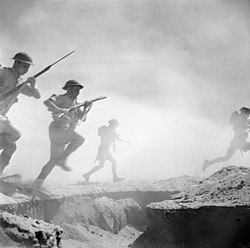
October 23, 1944 The Naval Battle of Leyte Gulf
The first Japanese force to be located by American forces was Kurita's Centre Force, encountered in the Palawan Passage early on 23 October by two US submarines, Darter and Dace. Kurita had unaccountably failed to deploy destroyers in an anti-submarine screen ahead of his heavy ships. Darter torpedoed and sank the heavy cruiser Atago, Admiral Kurita's flagship, and Dace torpedoed two heavy cruisers, sinking one - the Takao - and severely damaging the Maya, which was forced to withdraw.
The next day Third Fleet aircraft located the Centre Force. Despite its enormous strength Halsey's fleet was much less well placed to deal with the threat than it should have been. On 22 October Halsey had detached two of his groups to the fleet base at Ulithi to provision and rearm. When the Darter's contact report came in Halsey recalled Davison's group but allowed McCain, with much the strongest of Task Force 38's carrier groups, to continue towards Ulithi. Halsey finally recalled McCain's group on 24 October - but the delay meant that the most powerful group played little part in the coming battle, and Third Fleet was therefore effectively deprived of nearly 40% of its air strength. On the morning of 24 October only three groups were available to hit the Japanese Centre Force, and the one best positioned to do so - Bogan's - was, unfortunately for the US forces, the weakest, containing only one large carrier - Intrepid - and two light carriers.
Moreover, while they were preparing their first strikes against Kurita's force the northernmost of the three carrier groups - Sherman's - came under heavy air attack from aircraft based on Luzon. Three separate raids, each of50-60 aircraft, were repelled - with very heavy losses - by Sherman's fighters and AA fire, but one Japanese dive-bomber got through and hit the light carrier Princeton with a bomb which started fires. Later there was a hugeexplosion in her torpedo stowage which meant that she had to be abandoned. The explosion also damaged the cruiser Birmingham, which was alongside the carrier giving assistance. Terrible casualties were inflicted aboard the cruiser.
Despite all these difficulties Third Fleet - in what is known as the Battle of the Sibuyan Sea - attacked the Centre Force repeatedly during the day, making a total of 259 sorties against Kurita's ships. This force should, according to the Japanese plan, have had considerable land-based fighter cover during its approach to the Philippines, but in fact Kurita was never provided with more than than a token combat air patrol, and, even though his fleet had a large number of anti-aircraft guns (each battleship had 120 or more) their fire proved to be largely ineffective, probably because the gun crews had had very little combat experience. (It was noted that Kurita's AA crews seemed to be more effective towards the end of the Battle off Samar the following day - despite the fact that they must by this stage have been in a state of near-exhaustion).
Eighteen US aircraft were lost in these attacks. The carrier air groups concentrated on the enormous battleship Musashi. A succession of torpedo hits slowed her down and she fell behind Kurita's formation, but the attacks continued relentlessly and at 1935 she capsized and sank, having been hit by at least 10 bombs and the remarkable total of 19 torpedoes.
However, the relatively small number of aircraft attacking (compared with the total air strength of the Third Fleet), their concentration on sinking Musashi at the expense of crippling a large number of Japanese ships, and the inherent difficulty of hitting fast warships free to manoeuvre in the open seas meant that these attacks did not stop Kurita's fleet. The heavy cruiser Myoko was damaged by a torpedo and had to retire, and several other Centre Force ships received bomb hits which caused damage but did not substantially affect their fighting efficiency.
Although Kurita turned his ships away at 1500 he at 1714 resumed his course towards San Bernadino Strait - with a still very powerful force consisting of 4 battleships, 6 heavy cruisers, 2 light cruisers and a dozen destroyers - a force still fully operational and ready to fight.
An hour later he received a signal from Admiral Toyoda, Commander-in-Chief of the Combined Fleet -
"All forces will dash to the attack, trusting in divine assistance."
The Japanese Southern force consisted of two independent groups, Nishimura's group including its two elderly battleships, and a smaller group under Admiral Shima.  Both of these were sighted by American aircraft on the morning of the 24th., and Admiral Kinkaid, correctly surmising that these groups would attempt to attack the Leyte anchorage through Surigao Strait, was preparing to repel them. The Seventh Fleet had more than enough strength, in its battleships, cruisers and destroyers, to deal with the Southern Force.
Both of these were sighted by American aircraft on the morning of the 24th., and Admiral Kinkaid, correctly surmising that these groups would attempt to attack the Leyte anchorage through Surigao Strait, was preparing to repel them. The Seventh Fleet had more than enough strength, in its battleships, cruisers and destroyers, to deal with the Southern Force. The Japanese decoy force (the Northern Force) had remained undiscovered by the Americans until late on the 24th, but one of its search aircraft had located Sherman's Task Group Three at 0820. At 1145 Ozawa's carriers launched a strike consisting of 76 aircraft which failed to inflict any damage on Sherman's group. The Japanese pilots were so poorly trained that they could not return to their carriers but had to make for airfields
on Luzon after conducting their attack.
Halsey suspected that Japanese carriers were nearby, partly because the aircraft which had attacked Group Three in the morning were of carrier type (although these aircraft were in fact land-based). Air searches were conducted to the north and north-east but did not find Ozawa's battleships until 1540, and did not find the enemy carriers until an hour later.
Having located the Japanese carriers - which he regarded as both the main threat and the main prize - Halsey decided to concentrate his three available carrier groups, with all their accompanying vessels - including the six fast battleships - steam northwards with all this huge force, and annihilate Ozawa's ships during daylight on 25 October. Halsey took no steps to protect Seventh Fleet from the Centre Force.  Third Fleet left San Bernadino Strait entirely unguarded.
Third Fleet left San Bernadino Strait entirely unguarded.
As C. Vann Woodward writes "Everything was pulled out from San Bernadino Strait. Not so much as a picket destroyer was left."
Moreover Halsey did not even inform Kinkaid that the Strait was NOT now being covered by the Third Fleet - instead the Seventh Fleet commander had to rely on an intercepted signal, timed 2022, from Halsey to his task group commanders, which indicated that the Third Fleet commander was going north with the three carrier groups to strike the enemy Northern Force.
- instead the Seventh Fleet commander had to rely on an intercepted signal, timed 2022, from Halsey to his task group commanders, which indicated that the Third Fleet commander was going north with the three carrier groups to strike the enemy Northern Force.
Seventh Fleet had intercepted an earlier radio signal from Halsey which outlined a plan to form Task Force 34 - a very powerful surface force built around the Third Fleet's fast battleships, which was to be commanded by Vice Admiral Willis Lee.
When Halsey's 2022 message was received, Kinkaid and his staff, in the light of the intercepted "Task Force 34 will be formed . . ." signal, and not envisaging for a moment that the Third Fleet commander would allow the Japanese Centre Force to emerge from San Bernadino Strait entirely unopposed,  assumed that the "three groups" referred to were the carrier groups of Third Fleet, and that Task Force 34 had been left behind to guard San Bernadino Strait.
assumed that the "three groups" referred to were the carrier groups of Third Fleet, and that Task Force 34 had been left behind to guard San Bernadino Strait.
In fact Task Force 34 had not yet been formed, and all the ships which it was expected to contain were heading northwards with the American carriers. Meanwhile the Seventh Fleet, unconcerned about any threat from its northern quarter, and feeling fully confident that the Centre Force would be dealt with by Halsey and the Third Fleet,  continued with its preparations to meet the Japanese Southern Force in Surigao Strait.
continued with its preparations to meet the Japanese Southern Force in Surigao Strait.
The Battle of Surigao Strait 2300 October 24 - 0721 October 25
Rear Admiral Jesse B. Oldendorf, with 6 old slow battleships (five of which had been sunk or damaged at Pearl Harbor), 4 heavy and 4 light cruisers, and 26 destroyers, was charged with the task of stopping the Japanese Southern Force in Surigao Strait.
In addition 39 PT boats (motor torpedo-boats) were deployed beyond the Strait. At 2236 one of these, PT-131, made the first contact with the advancing Japanese ships. Over more than three-and-a-half hours the PT boats made repeated attacks on Nishimura's force, but without making any torpedo hits. Nonetheless they made contact reports which were of great assistance to Oldendorf's forces.
As Nishimura's ships entered Surigao Strait they came under devastating torpedo attack from American destroyers disposed on both sides of their line of advance. Both Japanese battleships were hit. The Yamashiro was able to steam onwards, but the Fuso blew up and sank. Three of the Van Force's four destroyers were also hit. Two of these sank, but the third, the Asagumo, was able to retire.
The American destroyer attacks were so successful that when the Japanese force came within range of the batteships and cruisers disposed across the Strait all it consisted of was the battleshipYamashiro, one heavy cruiser and one destroyer. The overwhelming gunfire of the Allied ships sank the Yamashiro and reduced the cruiser - Mogami - to a blazing wreck, but the destroyer, the Shigure, miraculously survived.
The rear of the Southern Force, the "Second Striking Force" commanded by Vice Admiral Shima, had approached Surigao Strait about 40 miles astern of Nishimura. It too came under attack from the PT boats, and one of these hit the light cruiser Abukuma with a torpedo which crippled her and caused her to fall out of formation. Shima next encountered remnants of Nishimura's force, including what he took to be the burning Fuso and Yamashiro but what were in fact the broken halves of the torpedoed Fuso. Shima, much discouraged, decided to withdraw, after which his flagship Nachi collided with the burning Mogami and was badly damaged. Mogami was later sunk by aircraft from the Seventh Fleet's escort carriers.
Oldendorf's force and the PT boats then harried the retreating Japanese. The last shots of the Surigao Strait battle were fired at 0721 when US cruisers and destroyers sank the destroyer Asagumo, torpedoed and damaged earlier in the battle.
At 0723 Oldendorf recalled his light forces from the pursuit.
Less than ten minutes later he received the astounding report that the Seventh Fleet's escort carriers had been surprised by the Japanese main force off Samar and were under heavy attack, a report which meant that the invasion shipping in Leyte Gulf - and the entire Leyte operation itself - was now in great danger.
The Battle off Samar - the Main Action Seventh Fleet contained a large task group of eighteen escort carriers, divided into three task units of six carriers each.
The main duties of these ships were the provision of combat air patrol over the Leyte beachhead and the invasion shipping, ground attack on Leyte, and anti-submarine patrol. They and their air groups were not trained or equipped to fight an enemy fleet.
At dawn on the 25 October the Seventh Fleet's three escort carrier units were operating off the east coast of Samar. In accounts of the battle these units are generally referred to by their radio call-signs "Taffy One", "Taffy Two" and (the most northerly of the three - Task Unit 77.4.3) "Taffy Three." This last unit, under the command of Rear Admiral Clifton Sprague, had by shortly after 0600 launched 12 fighters and also an anti-
submarine patrol of 6 aircraft to cover the ships in Leyte Gulf, as well as aircraft for Taffy Three's own protection.
It was therefore a very routine morning so far for Taffy Three. The threat from the Japanese Southern Force had been eliminated by Oldendorf's force during the previous night, and Halsey's Third Fleet with its immense strength lay to the north between the escort carriers and the Japanese Central and Northern forces. Or so Clifton Sprague and the men of Taffy Three believed.
But at 0645 AA fire was seen to the north-west, and a minute later the carrier Fanshaw Bay picked up a surface contact on radar.
At 0647 Ensign Jensen - the pilot of a plane from carrier Kadashan Bay - sighted, and then attacked, Japanese ships which he with remarkable accuracy identified as 4 battleships and 8 cruisers accompanied by destroyers.
Then, just before 7am, lookouts on the escort carriers saw the masts and fighting-tops of Japanese battleships and cruisers appear above the northern horizon. A minute later heavy shells began falling near Taffy Three.
The surprise was complete. Taffy Three was in a desperate situation, facing an exceptionally powerful force which also had a great superiority in speed over the escort carriers, while the only ships which Clifton Sprague had available to protect his flattops were the three destroyers and four destroyer escorts of his screen.
At 0657 Sprague had turned his carriers due east, begun working them up to their maximum speed of seventeen-and-a-half knots, ordered all his ships to lay smoke, and started to launch every available aircraft. At 0701 he issued a contact report and a call for assistance from anyone able to give it.
Japanese lookouts had sighted the escort carriers at 0644 when Kurita's ships were deploying from column into a circular anti-aircraft disposition.
Admiral Kurita then ordered "General Attack," permitting his ships' commanding officers to deploy against the US ships on their own inititative and without referring to the flagship. This was to mean that he lost control of the battle, and his giving such an order when his force was already engaged in redeployment caused immense confusion within the Japanese formation.
Shortly after the battle began Taffy Three's carriers entered a rain squall which protected them for about fifteen minutes and enabled Sprague to bring them around to the south-west - i.e. towards Leyte Gulf and the rest of Seventh Fleet.
At 0716 Sprague ordered his three Fletcher-class destroyers - Hoel, Heermann and Johnston - to counter-attack the Japanese formation. This they did with remarkable heroism and tenacity. They unflinchingly took on the battleships and cruisers, engaging these heavy ships with their 5-inch guns as well as their torpedoes.
At about 0750 the American destroyer escorts with equal heroism joined the counter-attack. At 0754 the vast battleship Yamato, now serving as Kurita's flagship after the sinking of Atago on 23 October, was forced to turn away for ten minutes by torpedoes from the American destroyers and was never able to get back into the action.
A very confused struggle by the DDs and DEs against the Japanese force continued for over two hours. By 0945 the Hoel and Johnston, and the destroyer escort Samuel B. Roberts, had been sunk by Japanese gunfire. At least one torpedo hit was made on Kurita's ships, and probably more, but what was of much greater importance was that the Japanese heavy ships had been forced into repeated evasive action and that this had slowed their advance, caused increasing confusion in the already badly disorganised Japanese formation, and deprived Kurita of any chance of regaining effective control of his force.
While the small ships of Clifton Sprague's screen were conducting these desperate counter-attacks the Japanese ships were also subjected to incessant assaults by aircraft from the three Taffies. Many of these attacks were carried out by aircraft armed with weapons intended for ground support and quite unsuited for attack on large warships, and many others were dummy attacks by unarmed aircraft.
Nonetheless, with the weapons available to them, the aircraft succeeded in sinking three heavy cruisers and damaging several other ships. These air attacks also played a vital role in support of the destroyers and DEs in distracting the enemy ships from the escort carriers, forcing them into evasive manoevres, and disorganizing the Japanese formation.
Despite all these heroic efforts the escort carrier Gambier Bay was eventually hit repeatedly by 8-inch gunfire, was crippled, and sank at 0907.
But then, entirely unexpectedly, and although his cruisers and destroyers were now on the verge of annihilating Taffy Three, Kurita at 0911 ordered his ships to break off action.
As Clifton Sprague later recalled -
"At 0925 my mind was occupied with dodging torpedoes when I heard one of the signalmen yell 'Goddamit, boys, they're getting away!' I could not believe my eyes, but it looked as if the whole Japanese fleet was indeed retiring. However, it took a whole series of reports from circling planes to convince me. And still I could not get the fact to soak into my battle-numbed brain. At best, I had expected to be swimming by this time."
While Taffy Three was fighting Kurita's ships, Taffy One was being subjected to the first organized kamikaze attack of the war. Later that morning Taffy Three itself was attacked by kamikazes. At about 1100 the escort carrier St. Lo was crashed by a Zero which caused a series of explosions, and she sank at 1125. Four more of the Seventh Fleet's escort carriers were damaged by kamikaze attack during 25 October.
Meanwhile, far to the north, Third Fleet was attacking the Japanese decoy force in the Battle off Cape Engano.
The Battle of Cape Engano
Shortly before midnight 24 October Halsey's three available carrier groups made rendezvous off Luzon and began a high-speed run northwards to strike the Japanese Northern Force at daybreak. Halsey now passed tactical command of Task Force 38 to Vice Admiral Mitscher. During the run northward the ships which were to make up Task Force 34 were detached from the carrier groups and Task Force 34 was officially formed at 0240 October 25, with Vice Admiral Lee as Officer in Tactical Command. This force swept northwards in the van of the carrier groups. Halsey's intention was that they would follow up with gunfire the carriers' attacks on Ozawa's ships.
At 0430 Mitscher ordered his carriers to begin arming their first deckloads and to be ready to launch aircraft at first light. He in fact launched his first attack groups, 180 aircraft in all, before the Northern Force had been located, and had them orbitting ahead of his carrier force while he was waiting for the first contact reports to come in from his search aircraft.
The first contact came at 0710. At 0800 Third Fleet's attacks on Ozawa began, meeting little opposition. Task Force 38's air strikes continued until the evening, by which time Mitscher's aircraft had flown 527 sorties against the Northern Force, had sunk Ozawa's flagship Zuikaku (last survivor of the six carriers which had launched the attack on Pearl Harbor) and two of the three light carriers, crippled the remaining light carrier, and sunk a destroyer, aswell as damaging other ships.
Meanwhile, at 0822 when Mitscher's second strike was approaching the Northern Force Halsey in New Jersey received an urgent signal in plain language from Kinkaid saying that the Seventh Fleet escort carriers were under attack off Samar and that assistance from Third Fleet's heavy ships was desperately needed. This was the first of a succession of pleas for help received by Halsey, which he ignored and continued to ignore for nearly three hours, despite their including an alarming report that the Seventh Fleet battleships were low on ammunition. Halsey continued to have Task Force 34 race to the north, while the men of Taffy Three were fighting for their lives and the Leyte invasion itself was being placed in jeopardy.
At 1000 the Third Fleet Commander received a message from Admiral Nimitz, Commander-in-Chief of the Pacific Fleet and Halsey's immediate superior. The message, as handed to Admiral Halsey, read -
"WHERE IS REPEAT WHERE IS TASK FORCE THIRTY-FOUR . . . THE WORLD WONDERS"
This message, indicating that Nimitz was alarmed about the safety of the Seventh Fleet and considered that the Third Fleet battleships should be in action off Samar, eventually persuaded Halsey to turn Task Force 34 around and send it south again. Rear Admiral Bogan's carrier group was also pulled out of the attack on Ozawa's force and sent south to provide air cover and support for Lee's force.
When Lee's battleships were pulled out at 1115 they were almost within gunfire range of the Japanese Northern Force.
Ironically it was by this time too late - if Halsey had turned Lee's force around when he first received Kinkaid's call for assistance the battleships and the cruisers (although not the destroyers which were low on fuel, but might in the circumstances have been left behind) could have arrived off San Bernadino Strait in time to cut off Kurita's withdrawal. As it was, Kurita's force, still containing four battleships and five heavy cruisers, had escaped through the Strait before the Third Fleet's heavy ships arrived there. All Task Force 34 could then accomplish was to sink the straggling Japanese destroyer Nowaki.
In any event, even if Task Force 34 had been turned southwards immediately after 0822, it would have arrived too late to have given any assistance to the ships of Taffy Three, other than in picking up survivors.
When the bulk of Task Force 34 was pulled out of the attack on Ozawa four of its cruisers and nine destroyers were detached under the command of Rear Admiral DuBose to proceed northward with the carriers. At 1415 Mitscher ordered DuBose to pursue Ozawa's ships. His cruisers sank the carrier Chiyoda at around 1700 and the American surface force at 2059 sank the destroyer Hatsuzuki after a stubborn fight.
At about 2310 the US submarine Jallao torpedoed and sank the light cruiser Tama of Ozawa's force. This was the end of the Battle off Cape Engano, and - apart from some final air strikes on the retreating Japanese forces on 26 October - the end of the Battle for Leyte Gulf.
The US had lost one light carrier and two escort carriers, two destroyers and a destroyer escort.
Between 23 and 26 October the Imperial Navy had lost one large carrier (the Zuikaku), three light carriers, three battleships including the giant Musashi, six heavy cruisers, four light cruisers, and twelve destroyers.
Major-General J.F.C. Fuller, in his book "The Decisive Battles of the Western World," writes of this outcome -
"The Japanese fleet had [effectively] ceased to exist, and, except by land-based aircraft, their opponents had won undisputed command of the sea. When Admiral Ozawa was questioned on the battle after the war he replied 'After this battle the surface forces became strictly auxiliary, so that we relied on land forces, special [Kamikaze] attack, and air power . . there was no further use assigned to surface vessels, with the exception of some special ships.' And Admiral Yonai, the Navy Minister, said that he realised that the defeat at Leyte 'was tantamount to the loss of the Philippines.'
As for the larger significance of the battle, he said 'I felt that it was the end.' "


